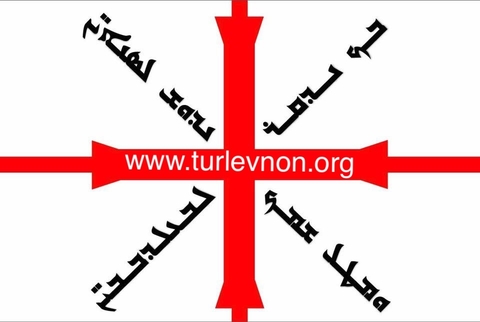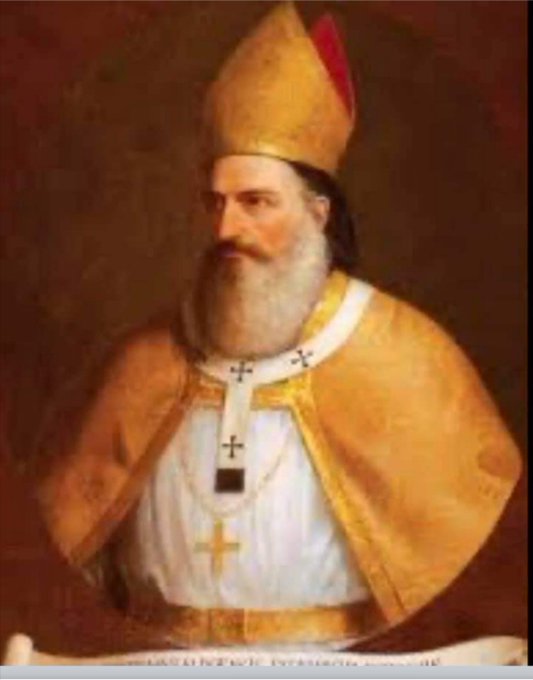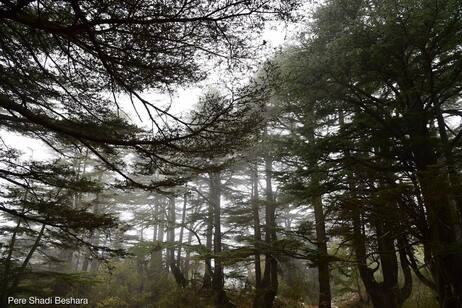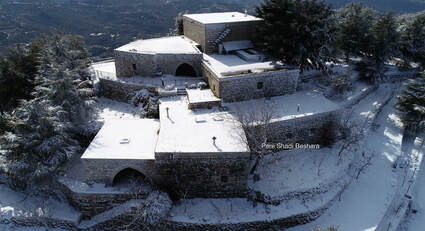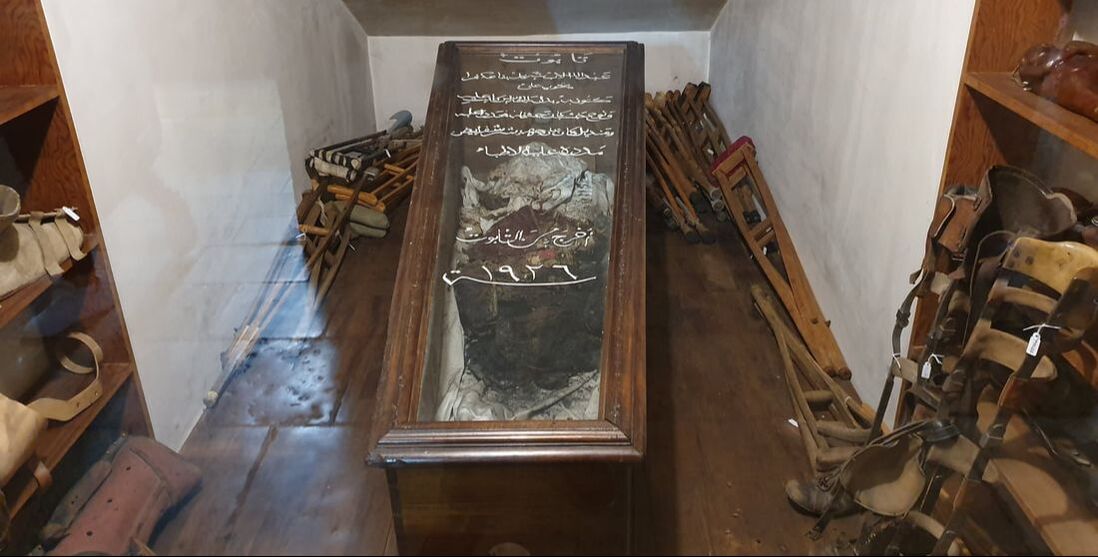HISTORY OF THE MARONITES:
LUBNAN WAL MAWARNAH TARIKH WA IMANE BY THE MARONITE CULTURAL CENTER (www.maronitecultural.center)
with english subtitle:
Part 1: https://tur-levnon.org/wp-content/uploads/2020/11/Lubnan-Wal-Mawarneh-Engtl-Part1.mp4
Part 2: https://tur-levnon.org/wp-content/uploads/2020/11/Lubnan-Wal-Mawarneh-EngtlPart2.mp4
with spanish subtitle:
.
“>https://tur-levnon.org/wp-content/uploads/2020/11/Lubnan-Wal-MawarnahSpanishSubtitleTL.mp4
http://www.maronite-heritage.com/History.php
- Aspects of Maronite History: http://www.maronite-heritage.com/Aspects%20of%20Maronite%20History.php
According to William Harris Maronites constitute the first religious community who inhabited phoenician Lebanon. They were followed by Druzes (758), Shiites (980) and Sunnis (1305).
Lebanon a history, 600-2011 by Harris, William WilsonPages24A26
Buy it at: https://www.amazon.com/Lebanon-History-Studies-Middle-Eastern-ebook/dp/B00A2NLC6G
_______________________________________
SAINT MARON: MOR MOROUN:
- http://www.maronite-heritage.com/LNE.php?page=Saint Maronp
- https://en.wikipedia.org/wiki/Maron
- Background :Saint Maroun, born in the middle of the 4th century was a priest who latter became a hermit, retiring to a mountain of Taurus near Antioch. His holiness and miracles attracted many followers, and drew attention throughout the empire. St John of Chrysostom sent him a letter around 405 AD expressing his great love and respect asking St Maroun to pray for him.The Maronite Movement:St Maroun is considered the Father of the spiritual and monastic movement now called the Maronite Church. This movement had a profound influence on Northern Syria and Lebanon. Saint Maroun spent all of his life on a mountain in the region of Cyrrhus in Syria. It is believed that the place was called “Kefar-Nabo” on the mountain of Ol-Yambos, making it the cradle of the Maronite movement.The Maronite movement reached Lebanon when St Maroun’s first disciple Abraham of Cyrrhus who was called the Apostle of Lebanon, realised that paganism was thriving in Lebanon, so he set out to convert the pagans to Christians by introducing them to the way of St Maroun. The followers of St Maroun, both monks and laity, always remained faithful to the teachings of the Catholic Church.Spirituality:St Maroun’s way was deeply monastic with emphasis on the spiritual and ascetic aspects of living. For Saint Maroun, all was connected to God and God was connected to all. He did not separate the physical and spiritual world and actually used the physical world to deepen his faith and spiritual experience with God.St Maroun embraced the quiet solitude of the mountain life. He lived his life in open air exposed to the forces of nature such as sun, rain, hail and snow. His extraordinary desire to come to know Gods presence in all things, allowed St Maroun to transcend such forces and discover that intimate union with God. He was able to free himself from the physical world by his passion and fervour for prayer and enter into a mystical relationship of love with God.Mission:St Maroun was a mystic who started this new ascetic-spiritual method that attracted many people in Syria and Lebanon to become his disciples. Accompanying his deeply spiritual and ascetic life, he was a zealous missionary with a passion to spread the message of Christ by preaching it to all he met. He sought not only to cure the physical ailments that people suffered, but had a great quest for nurturing and healing the “lost souls” of both pagans and Christians of his time.This missionary work came to fruition when in the mountains of Syria, St Maroun was able to convert a pagan temple into a Christian Church. This was to be the beginning of the conversion of Paganism to Christianity in Syria which would then influence and spread to Lebanon. After his death in the year 410 AD, his spirit and teachings lived on through his disciples.
_____________________________________________
TIMELINE CHRISTIAN HISTORY:
LIST OF PATRIARCHS:
- https://en.wikipedia.org/wiki/List_of_Maronite_Patriarchs_of_Antioch
- http://www.maronite-heritage.com/Maronite%20Patriarchs.php
- Patriarch Bechara Raii:
______________________________________
Saint John Maron – Mor Youhanna Maroun:
- https://en.wikipedia.org/wiki/John_Maron
- John Maron (628 – 707), was a Syriac monk, and the first Maronite Patriarch. He is revered as a saint by the Catholic Church, and celebrated on March 2
- Early life: John was born in Sarum, a town located south of the city of Antioch. He was the son of Agathon and Anohamia. He was called John the Sarumite since his father was governor of Sarum. His paternal grandfather, Prince Alidipas, was the nephew of Carloman, a Frankish Prince, and governed Antioch. John was educated in Antioch and the monastery of Saint Maron studying mathematics, sciences, philosophy, theology, philology and scripture. He became a monk at the monastery of Saint Maron, adding the name Maron to his own John studied Greek and patrology in Constantinople. Returning to Saint Maron’s, he wrote on such diverse topics as teaching, rhetoric, the sacraments, management of Church property, legislative techniques, and liturgy. He composed the Eucharistic Prayer which still bears his name. As a young priest he engaged himself in ecumenical debates with the Monophysites. Noted as a teacher and preacher, he explained Catholic dogma of the Council of Chalcedon (which focused on the nature of Jesus as both God and human), wrote a series of letters to the faithful against Monothelitism, and then travelled Syria to explain the heresy. He was consecrated bishop in 676, but assigned to Mount Lebanon with a mission to oppose heresies, keep the Maronites united with the Church, and support the faithful in an area being invaded by Arabs. He travelled extensively in the areas involved in combat, preaching, conducting Mass, tending to the sick, and sheltering the homeless. It was during this terrible period that he was given the gift of healing, curing many praying over them.The first Maronite Patriarch
- The Maronites made up the bulk of the Maradite army, the so-called “Brass Wall” that shielded Constantinople and the Byzantine Empire from Arab expansion. In 686 the Maradites used their power and importance to choose John Maron, one of their own, as Patriarch of Antioch and all the East. John received the approval of Pope Sergius I, and became the first Maronite Patriarch of the oldest See in Christianity.
_____________________________________
- Gabriel II of 7ajoula: Patriarch
- yr (1357-1367) lived at Sainte Ilij convent. The Mamalik burnt him by fire in Tripoli where he is buried.
____________________________________________MAR ESTÉPHANOS BOUTROS DOUWAIHI:
We owe him our motto: “After our faith, our doctrine is the land of Lebanon” (Botar haymonutan:ar3o dlevnon hi qyomo dilan). He confirmed the identity and the nation of our people.
- or Estephanos Douwayhi Patriarko d’Levnon d’Suryoyé Morunoyé ܐܠܣܪܝܐܢܝ ܣܪ ܠܝ ܐܠܥܪܒܝ ܥܐܪ ܒܝ Every year, on August 2, Tur Levnon organizes a mass for our great Patriarch.
Syriac maronite mass in Zghorta celebrated by Tur Levnon on 11 august 2019 to honour Mor Estaphanos Douwayhi:
https://tur-levnon.org/wp-content/uploads/2020/09/DouwayhiMass11august2019DrAmineIskandarTL.mp4
االمكرّم البطريرك العلامة اسطفان الدويهي الإهدني
اعداد الباحث روي عريجي – الحركة الإهدنية
بمناسبة عيد مولد المكرّم العلّامة البطريرك اسطفان الدويهي الاهدني، وفي اطار استذكارها لعظماء سنضع امامكم لمحة عن بطريركنا القديس.
ولد في إهدن في اليوم الثاني من شهر آب من السنة 1630، يوم تذكار عيد القديس اسطفانوس رئيس الشمامسة وأول الشهداء فدعاه والداه باسم هذا القديس الشهيد.
تعلّم القراءة السريانية والعربية ومعرفة مبادىء الديانة وطقوس الكنيسة المارونية في ظل كنائس رعية إهدن-زغرتا وكان انصبابه على الدرس مشفوعًا بالتّقوى.
اختاره العلامّة البطريرك جرجس عميرة الاهدني وأرسله الى المدرسة المارونية في روما التي تأسست في 27 حزيران 1584. وعُرِضت عليه مراكز عليا في روما ففضّل العودة إلى لبنان سنة 1655.وفي سنة 1656، في 25 آذار يوم عيد البشارة، رقاه البطريرك يوحنا الصّفراوي إلى درجة الكهنوت على مذبح كنيسة دير مار سركيس وباخوس رأس النهر في إهدن. ثم سكن دير مار يعقوب الأحباش في إهدن بعد أن رمّمه وابتدأ يعلم أولاد اهدن في المدرسة التي افتتحها هناك بالاضافة الى وعظ الشعب فتميز فيه.
لأنه كان حذقٌا في الوعظ، أرسله المطران صفير الى حلب واعظا”.
أعاد عددًا وافرًا من الإخوة في الكنائس الشرقية إلى حضن الكنيسة الأم.
أسّس في حلب المدرسة المارونية الشهيرة سنة 1666. عيّنه البطريرك جرجس البسبعلي مطرانا” على أبرشية قبرس في 8 تموز 1668، بعد زيارته الأراضي المقدسة هو وأسرته. فنظم الكنيسة المارونية هناك وجمع كل الوثائق والكتب المتعلقة بتاريخ الموارنة.
في العشرين من أيار من سنة 1670 انتُخِب بطريركا” بعد أن كان قد رفض هذا المركز لكثرة تواضعه. فاتخذ دير سيدة قنوبين مقرًّا له ولاقى طيلة سنيّ البطريركية ال34 اضطهادات ومنازعات وملاحقات عديدة ممّا دفعه للانتقال من مغارة الى أخرى للاختباء. في عهده أرسل الكثير من التلامذة الى المدرسة المارونية في روما. تميز بصفات الأبوة تجاه جميع الموارنة وظل يعلّم الشعب و يعظ، وكان يفحص الكتب الطقسية المخطوطة ويصلح ما أوقعه النساخ من خطأ أو نقص ويجمع تواريخ هذه البلاد.
بالرغم من الاضطهادات و المنازع وعدم تمكّنه من الركون إلى الراحة والاستقرار ظل مثابرًا على الكتابة والتصنيف والكد والتأليف في المغاور والبراري التي كان يلجأ اليها.
فوضع عدة تآليف في اللاهوت والتاريخ والعقيدة المسيحية والرتب الكنسية والاسرار.
كان يهتم بكهنة الرعايا اهتمام الأب لاولاده فكان يتمتع بروح العدل والمحبة . ورغم الاوضاع الصعبة في البلاد كان يجول على الابرشيات والرعايا ويكرس الكنائس والاديرة حتى بلغ عددها حوالي 35 كنيسة في كل المناطق اللبنانية.
توفّي البطريرك العلّامة اسطفان الدويهي الاهدني في قنوبين في 3 ايار سنة 1704.
أصدر المجمع لدعاوى القديسين مرسومًا بتطويب الدويهي في 5 كانون الأول 1996. وشرعت بطريركية انطاكية للموارنة مع لجنة التحقيق والأبرشية، إلى تقديم نتائج المجمع، الذي صادق على إجراء بمرسوم مؤرخ في 8 تشرين الثاني 2002. ونشرت أسباب التطويب في عام 2005 وقد حصلت على موافقة لجنة المجمع التاريخي المختصة بدعاوى القديسين في 24 كانون الثاني 2006. يوم 3 تموز 2008 أعلن البابا بنديكتوس السادس عشر البطريرك اسطفان الدويهي مكرّمًا جديدًا في الكنيسة الجامعة الكاثوليكية وأعلن بطولة فضائله من قداسة في الجلسة “Udienza Ex” حيث التقى قداسته رئيس مجمع القديسين نيافة الكاردينال خوسيه سرايفا مرتينس الساعة الأولى بتوقيت روما وأبلغه قرار اعلان البطريرك الدويهي مكرّمًا. وصدر هذا القرار في الجريدة الرسمية “Romano Losservatore” ومختلف وسائل الإعلام داخل الفاتيكان وخارجه.”
في 16 كانون الأول سنة 2020، وقّع البطريرك الماروني الكاردينال مار بشارة بطرس الراعي على الملف الملحق لدعوى تطويب البطريرك اسطفان الدويهي، لرفعه الى مجمع القديسي في روما للاطلاع عليه، لتصبح كل المعطيات الطبية والعلمية قد وضعت بتصرف المجمع حول أعجوبة الشفاء التي حصلت بشفاعة الدويهي مع السيدة روزيت الدويهي الذي وقف الطب عاجزاً عن شفائها من مرض السرطان.
• ذُكر النص في كتابي ” قديسو لبنان”
• الصورة المرفقة هي للبطريرك الدويهي من مجموعة الأستاذ بيارو زخيا الدويهي.History of Lebanon by Mar Estephan Boutros Douwayhi:
Le cinquante-septième patriarche maronite sur le siège d’Antioche depuis le fondateur saint Jean Maron, Estéphanos Douaihy, était épigraphiste, archéologue, musicologue et philologue. Au XVIIe siècle, il s’est mérité le titre de père de l’histoire et principal patriarche, suivant ainsi les pas du saint fondateur du VIIe siècle, tout en réformant l’Église et préservant son héritage.
Mille ans après saint Jean Maron, un grand patriarche allait réaffirmer l’idée du Liban en inscrivant dans l’écriture de l’histoire ce que le premier avait établi sur le territoire. L’un avait quitté Antioche pour le Mont-Liban, où il repose à Kphar-Haï en 707, tandis que l’autre quittait Rome pour cette même montagne sacrée, où il fut inhumé en 1704 à Sainte-Marina de Qannoubine.
Estéphanos Douaihy fut le 57e patriarche maronite sur le siège d’Antioche depuis le fondateur saint Jean Maron. Né à Ehden le 2 août 1630, jour de la saint Étienne dont il portait le nom en syriaque, il perdit son père, Mikhael, trois ans plus tard, et fut éduqué par sa mère Mariam qui l’inscrivit à l’école du village pour apprendre le syriaque, comme il le raconte dans son autobiographie. Plus tard, le patriarche Georges Amira le choisit pour partir à Rome à l’âge de 11 ans, où il séjourna de 1641 à 1655.
Du collège au patriarcat
À Rome, il était connu sous le nom de grand Edenensis. Il refusa les offres alléchantes qui avaient attiré ses collègues savants maronites tels qu’Ecchellensis, Sciadresis, Hesronita, Sionita, les Assémani et d’autres encore.
Ces opportunités, telles que des chaires universitaires et des postes de conservateurs dans les plus grandes bibliothèques d’Occident, étaient très honorifiques et rémunératrices. Malgré cela, Estéphanos insista pour retourner au Mont-Liban, sentant qu’il avait une mission divine à accomplir. Avant de prendre la mer, il multiplia ses recherches dans les bibliothèques européennes et copia des documents concernant les Maronites, le Levant et la Mésopotamie.
À son retour au Mont-Liban, le patriarche Jean de Safra l’ordonna prêtre le 25 mars 1656. Le 8 juillet 1668, Georges de Bsebeél le consacra évêque maronite de Chypre, et le 5 mai 1670, il fut élu patriarche sur le siège d’Antioche. Il devint alors connu en Occident sous le nom de Stephanus Petrus Edenensis Patriarcha Antiochenus Maronitarum.
Peu de patriarches furent autant contestés que Estéphanos Douaihy. Il dut fuir la tyrannie des Turcs et de leurs vassaux Hamadé dans le nord du Liban, se réfugiant dans le Kesrouan où il fit face à l’opposition de son propre clergé et de la féodalité, notamment un influent Khazen. Certains évêques s’opposèrent à toutes ses réformes et contestèrent son élection, retardant l’approbation de Rome jusqu’en 1673. Cette situation le poussa à quitter le Kesrouan hostile pour s’installer plus au sud, chez les princes Maanides à Majdel-Méouch, parmi les druzes qui le protégèrent et le vénérèrent parfois comme un saint.
Il étudia longuement les coutumes des druzes et leur attitude envers les chrétiens. “Au pays du prince Fakhredine”, écrivait-il, “la tête des chrétiens s’est relevée. Ils ont commencé à monter à cheval, à porter des écharpes sur la tête et à manier des fusils. Pendant ce temps, des églises ont été construites à Bikfaya, Arbénié, Bchéelé, Kphar-Zayna et Kphar-Helta. Des missionnaires d’Occident sont venus vivre parmi nous.”
Un patriarche polyglotte
Trilingue, Estéphanos écrivait parfaitement le syriaque et l’italien, et maîtrisait assez bien l’arabe, bien que sa syntaxe révèle qu’il pensait principalement dans ses deux premières langues. Il écrivait également en latin à un moindre degré, et connaissait le grec et le français. Pour s’adresser aux consuls de France à Alep, François Picquet et François Baron, il préférait cependant utiliser l’italien.
Il a lui-même enseigné les langues. À Geïta, le syriaque, à Alep, le syriaque, l’arabe et l’italien. À Mar-Chalita (Sainte-Artémis) de Gosta, il a écrit des lettres en français pour souligner le besoin de protection occidentale.
Entre 1653 et 1658, puis lors de sa seconde mission entre 1662 et 1668 à Alep, où la communauté maronite parlait arabe, il prêcha et écrivit dans cette langue. Il perfectionna son arabe en utilisant le garshouné (arabe écrit en caractères syriaques) pour certains de ses ouvrages historiques.
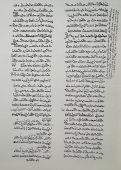
L’écriture du patriarche Estéphanos Douaihy dans le manuscrit des “Strophes types syriaques”. L’arabe comme langue étrangère
Malgré son recours à la langue arabe sous forme de garshouné, il insérait des textes liturgiques en langue syriaque sans en fournir la traduction, car il percevait la sacralité, les richesses et les vertus du syriaque. Mais ce savant se méfiait aussi des obstacles liés à la traduction et des trahisons qu’elle pouvait induire.
Son arabe apparaissait comme une langue étrangère. C’est précisément le sens du terme garshouné pour désigner la langue arabe, qui signifiait “l’étranger”. Les textes de Douaihy étaient fortement imprégnés de tournures syriaques arabisées, caractéristiques du dialecte libanais. Il commettait parfois des fautes de grammaire et n’utilisait que très rarement le duel distinctif de la langue arabe.
Sous l’influence d’Alep et, surtout, des encouragements du Vatican, il promut l’usage de l’arabe dans son Église, y voyant une ouverture vers l’universalisme, tout en restant vigilant contre l’acculturation de son peuple. Il lança ainsi un avertissement en garshouné, sous forme de vers: “Al syriani serr li, al ‘arabi ‘ar bi” (le syriaque est un mystère pour moi, l’arabe une honte), signifiant que l’ouverture vers une autre culture ne doit pas se faire au détriment de la langue ancestrale et identitaire, qu’il désignait comme “la nostra lingua siriaca” (notre langue syriaque).
Dans l’ouvrage “Le Candélabre des Saints Mystères”, conservé dans le manuscrit 111 de Kreim, page 146, Estéphanos Douaihy insistait pour que la messe maronite soit célébrée en syriaque, particulièrement lors des paroles de la consécration eucharistique.
“Le Candélabre des Saints Mystères”
L’œuvre de ce grand patriarche, particulièrement “Le Candélabre des Saints Mystères”, reflète ses vastes connaissances et sa polyvalence; c’est son œuvre la plus importante pour l’héritage maronite. Il s’agit d’une somme théologique et liturgique encyclopédique qui résume l’identité maronite dans tous ses aspects: artistique, iconographique, architectural, musical, liturgique, théologique et littéraire.
Pour écrire l’histoire et préserver l’héritage de son peuple, Estéphanos Douaihy se basa sur des sources recueillies dans les bibliothèques européennes, les écrits de l’évêque Gabriel Barcleius, ainsi que ses propres recherches à travers les villages et monastères du Liban, où il découvrit des manuscrits riches en informations, tant dans les textes que dans les marges. Parmi eux, il mentionne notamment le livre du Hacho de Maad, ainsi que ceux de Bchéelé, Hadchit et une Chhimto de Mar-Aboun de Hegoula.
Épigraphiste, archéologue, musicologue et philologue, réformateur de l’Église et gardien de son héritage, Estéphanos Douaihy a pleinement mérité son titre de père de l’histoire et principal patriarche, suivant ainsi les traces du fondateur saint Jean Maron.
________________________________________
البطريرك العلامة جرجس عميرة الاهدني(1568-1644)
اعداد الباحث روي عريجي – الحركة الإهدنية
في إطار استذكار عظماء وشهداء اهدن تستكمل الحركة الإهدنية تكريم هؤلاء الذين كانوا غنى لإهدن وللموارنة ولبنان.
وبمناسبة الذكرى الـ 377 على وفاة البطريرك الماروني جرجس عميرة، والذي صادف أمس الأول، الذي كان أول تلميذ اهدني دخل المدرسة المارونية في روما وأول بطريرك تخرج منها، وهذه المدرسة تأسست في 27حزيران من سنة 1584 بعد اعلان قداسة الحبر الأعظم البابا غريغوريوس الثالث عشر وأنجبت رجالًا عظماء و علماء مشاهير رفعوا شأن الطائفة المارونية.
ولد جرجس عميرة سنة 1568 في اهدن أرسله البطريرك سركيس الرزي البقوفاوي سنة 1584 الى روما لتلقي دروسه في المدرسة المارونية وسيم كاهنًا سنة 1595 عند عودته الى لبنان وأسقفًا على مطرانية اهدن سنة 1600 على يد البطريرك يوسف الرزي البقوفاوي، وسنة 1634 انتخب بطريركًا على الطائفة المارونية وبعد حياة حافلة بالمآثر الدينية والثقافية والوطنية انتقل الى رحمته في قنوبين في 29 تموز سنة 1644. كان معروفًا بضلوعه باللغة السريانية وألّف أول غراماطيق (كتاب قواعد) سرياني – لاتيني واهتم بطبع كتاب القداس في روما.
وكان البطريرك جرجس عميرة عالمًا، لاهوتيًا، فيلسوفًا، خبيرًا في هندسة الأبراج والقلاع وفي أصول الدفاع.
كان صديق الأمير فخر الدين المعني مذ كان مطرانًا وساهم المساهمة الكبيرة باستمرار الامارة في دير القمر عبر استجلاب دعمًا من الحبر الأعظم.
وفي 16 كانون الاول سنة 2018 ازيحت الستارة عن تمثال نصفي لهذا البطريرك العظيم نحته الفنان الإهدني سايد بو محرز قدمته جمعية إحياء التراث الإهدني التي يرأسها المطران بولس أميل سعاده ونُصب في ساحة كنيسة سيدة زغرتا.
______________________________________________
MARONITES SAINTS WHO SPOKE AND PRAYED IN SYRIAC:
- SAINT CHARBEL:
- http://www.maronite-heritage.com/LNE.php?page=Saint Sharbel
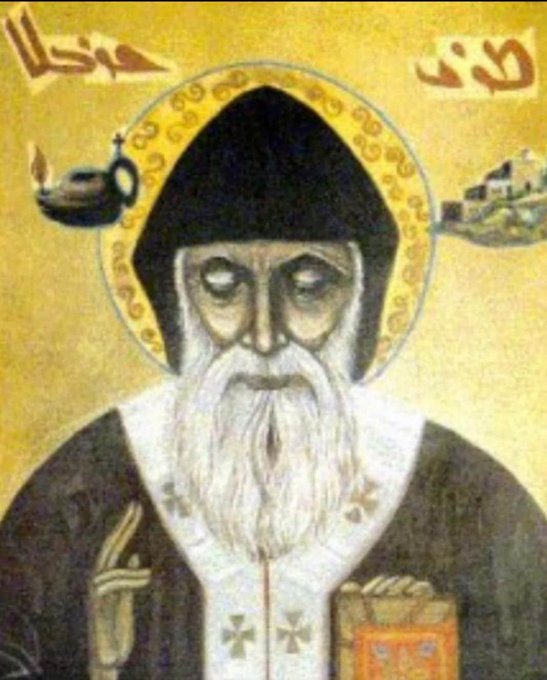
Saint Charbel’s Biography
His Life On Earth Saint Charbel Makhlouf was born in Bekaa Kafra on May 8, 1828. Bekaa Kafra is a small mountain village, the highest in Lebanon and the Middle East, 5118 feet (1560 meters) above sea level, in the region of Bsharri (North Lebanon). In its vicinity are the ancient Cedars of Lebanon, called by the Lebanese, “the Cedars of the Lord.” Bekaa Kafra overlooks the valley of Qadeesha, where Sharbel had two uncles living as monks in the monastery of Saint Anthony of Kozhayah. They were a source of inspiration and models for him. | The Cedars of Lebanon. Image by Fr. Shadi Beshara |
Along with other children, Youssef learned Arabic and Syriac from the priest of the village.
He received his formation in theology at the monastery of Saints Cyprian and Justina in Kfifan between the years 1853 and 1859. Father Nemtallah Kassab El-Hardini (canonized on May 17, 2004) was the teacher of Saint Sharbel and his fellow seminarians.
On July 23, 1859 Saint Sharbel was ordained priest of the Lebanese Maronite Order. He spent 16 years (1859–1875) in the monastery of Annaya, praying and working in the fields with his brother monks. He was unhesitatingly obedient to his superiors, faithfully observed all the rules, and lived a life of sacrifice under austere conditions.
The Hermitage of Saints Peter and Paul in Annaya, Lebanon. Image by Fr. Shadi Beshara | His request to move to the hermitage of Saints Peter and Paul, on a nearby hill, was approved after his superior witnessed the “miracle of the lamp.” One night, Saint Sharbel asked a worker at the monastery to refill the oil lamp that he was using. Although the worker filled it with water instead of oil, the lamp still gave light as usual and kept burning throughout the night. |
While celebrating the Divine Liturgy on December 16, 1898, he suffered a stroke and endured eight days of terrible pain calmly, silently, and prayerfully. Saint Charbel kept repeating the prayer he could not finish in the Divine Liturgy: “Father of truth, behold Your Son, the sacrifice in whom You are well pleased. Accept Him who died for me…”. He would also repeat the names of Jesus, Mary, Joseph, as well as Saints Peter and Paul, the patron saints of the hermitage. He died on Christmas Eve, 1898, and was buried at the monastery on a very cold and snowy day. Only a few monks were able to attend his burial ceremony.
Following his death, people started to report seeing lights around his tomb. When Church authorities opened the tomb, they found Saint Charbel’s body incorrupt and exuding sweat and blood.
On April 15, 1899, the Maronite Patriarch allowed the body to be transferred to a special coffin, which was placed in a new tomb, inside the monastery. Pilgrims began flocking to his tomb and praying for his intercession. God granted many of them physical healings and spiritual blessings.
Because of the exuding of sweat and blood, Saint Charbel’s coffin and tomb had to be changed several times through the years. On July 24, 1927, the body was transferred to a third tomb.
In 1950, Saint Charbel’s tomb was opened in the presence of certified doctors and members of an official committee from the Church and the Lebanese government, who verified the integrity of the body. They wrote a medical report and put it in a box inside the coffin. Immediately, healings proliferated in an amazing fashion! Tens of thousands of pilgrims of different religions and communities flocked to the monastery of Annaya, asking the intercession of the holy hermit. Saint Charbel’s body continued to bleed and perspire for sixty-five years after his death.
Beatification of Charbel
| Icon of Saint Sharbel. |
On October 9, 1977, His Holiness Saint Paul VI presided over the canonization ceremony of Blessed Carbel in the Vatican basilica. The miraculous healing of Miriam Awad from throat cancer in 1967 was accepted as the official miracle for canonization.
- Sainte Rafqa:
- http://www.maronite-heritage.com/LNE.php?page=Saint Rafqa
- Saint Nimutallah Hardini:
- http://www.maronite-heritage.com/LNE.php?page=Saint Nimatullah Hardini
- Abouna Yacoub:
- http://www.maronite-heritage.com/LNE.php?page=Bouna Yacoub
- Brother Estephan Nehmé:
- http://www.maronite-heritage.com/LNE.php?page=Brother Estephan Nehme
_______________________________________________
SAINT EPHREM: Harp of the Holy Spirit:
Mor Ephrem and the Syriac Identity
Mor Ephrem was born in Nisibis in 306. This city was being fought over by the Byzantines and the Persians for decades. In his writings, Mor Ephrem used to defend his land and people with a clear knowledge of belonging to a certain group and culture. Mor Ephrem, like all the Syriacs, had to leave his land in Nisibis. He settled in Orhoy – Edessa where he became responsible of its famous school. In 363, Nisibis fell to the Persians. The Saint went on writing about his city and denouncing its occupation [1].
In Edessa as well, Mor Ephrem had to face the domination of the Hellenistic culture and a certain hegemony of the Greek language inside the Christian Semitic world. By developing his countless Mimré, he imposed a Christian Aramaic literature that will end up being adopted in all the other Christian traditions of the East and the West.
Even if this great Saint became a symbol of Syriac literature, even if he was called “the Prophet of the Syriacs” or “the Cithara of the Holy Spirit” (Kénoro drouh qoudsho), the messages of his texts had nothing to do with nationalism or Syriac identity. His defense of Nisibis against the Persians is an exception among his hundreds and thousands of Mimré about love, faith and Virginity. Moreover, let us not forget that, in his writings concerning Nisibis, he was defending mostly Christians against Pagans, not Syriacs against Persians.
Mor Ephrem’s Mimré are all about Love, Nativity, Virginity, Mary, Joseph, Faith and God. The essence of all his thinking is about abandoning every thing for God. That is abandoning even ourselves for the love and grace of the Lord. In that, Mor Ephrem is typically and deeply Syriac. His writings summarize the state of mind of the Syriacs and the austerity of their Church, as well as its attitude of abnegation and complete humility. The will to lead a life similar to that of the Savior, and to get closer to Him through our acts and our faith, seems to have dominated the behavior of the Syriac Churches since their early conception. This explains their determination to blend in the Western society as they did in the Eastern society [2], even in Edessa, the motherland of Syriac language, in which some of them ended up adopting the Armenian language.
Let us say that in general, contrary to their Armenian neighbors, the Syriacs are rarely held to conserve their linguistic particularity. Not withstanding their total integration in the West [3], we already notice a growing tendency in the East towards a systematic acceptance of the dominant language in the environment in which these Syriacs evolve.
In the regions that are dominated by the Kurds or the Turks, the Syriacs have adopted the languages of these people. Further to the South, the Syriacs are Arabic speaking people. This was the case in the region of Mardin, where Arabic is now fading being replaced by the Turkish language instead. In Lebanon, the Syriac Maronites have adopted Arabic as their every day language and integrated it even in their liturgy. The Edessians that inhabit Lebanon today, have continued to practice Armenian up till now and use Syriac only in their liturgy.
With Abgar VIII, king of Edessa from 179 to 212, who converted to Christianity in 206, the first Christian state in history was born. This first Christian kingdom which was created by the Syriacs in Edessa dwindled and relinquished its place to Armenia (proclaimed Christian circa 301-314) followed by the Roman Empire and Ethiopia (circa 325-330).
Armenia, Ethiopia and all the other Christian kingdoms that followed witnessed painful and glorious episodes throughout their history. Only the Syriacs were content with being a Church and with being identified with this Church rather than with a nation or even a language.
When Mor Ephrem speaks of pure hearts, he really means to talk about the Good in humanity. That is why he mentions Saint Matthew (Matt. 5: 8):
ܛܘܽܒܰܝܗܘܢ ܠܐܰܝܠܶܝܢ ܕܰܕܟܶܝܢ ܒܠܶܒܗܘܢ . ܕܗܶܢܘܢ ܢܶܚܙܘܢ ܠܐܰܠܳܗܐ.
« Blessed are the pure in heart, for they shall see God »
This sentence has nothing to do with what the 15th century Syriac Maronite scholar, Gabriel Barcleius writes. When Barcleius talks about pure hearts, he means people who are Syriacs, and Catholics and Maronites and inhabiting the sacred mountains of Lebanon [4]. Therefore, he already reveals in the 15th century, a Syriac Maronite national aspiration, that is part of the larger scale Syriac identity. However, his greater master, Mor Ephrem, did not seem to see things that way in most of his work. After mentioning Saint Matthew in the Commentary on the Diatessaron, he goes on explaining that one is supposed to see through the eyes of his soul or those of his heart, not through his physical vision [5]. We are projected in a spiritual dimension, away of all kind of earthy interests. For Mor Ephrem, the “mirror” of the Gospel permits us to see our true self [6]. Therefore, the principal aim in life is to purify the heart to be able to reflect the original beauty, that is the image (Salmo) of God in which he created man [7].
All this spirituality and abnegation as well as its continuous illustration with mirrors and all kind of every day’s objects, is typically Syriac and differs from the Greek and Latin traditions [8]. John of Dalyatha and many other Syriac writers used the image of the mirror to take us through there spiritual explorations.
The description about God dominates Ephrem’s literature to become an example for man to follow. All a Christian’s life should be is a continuous struggle to get closer to God’s image. On this subject, Mor Ephrem writes:
He clothed Himself in the likeness of man
In order to bring man to the likeness of Himself
Lord, You bent and put on humanity’s types
So that humanity might grow through Your self-abasement.
How wonderful is this abundance
That the Lord should be poured out in us continually,
For He has left the heavens and descended:
Let us make holy for Him the bridal chamber of our hearts [9].
In respect to all these spiritual values, the Syriac Church and the Syriac people are continuously inclined towards ascetism and monastic life. Such a detachment from the world does not encourage conscience national aspirations. However, it is necessary to point out here the fundamental difference between the Syriac Antiochian monastic tradition and that of the Antonian tradition that takes its sources in Upper Egypt [10].
Monastic life in respect to Saint Aphraate and Saint Ephrem is understood as isolation away from women. Where as, for Saint Anthony and Saint Pacôme, this includes isolation from the world. As Father Georges Rahmé says [11], the monastic value in Upper Egypt sees itself as a retreat in the desert, using therefore exterior boundaries to accomplish seclusion. In Upper Mesopotamia and Phoenicia-Mount-Lebanon, it seeks to develop in the heart of society, protecting itself only with interior boundaries. The seclusion is only interior.
This difference (between Antiochian and Antonian traditions) is fundamental for our commentary on Syriac identity. In fact, Mor Ephrem never isolated himself from his people. In his writings about Bishop Vologese, he likes to point out that monastic life does not oppose with apostolic and pastoral missions [12]. The Syriac monk is supposed to serve his people and guide them by living between them and with them. Hi influences his people. He is a Malpono [13] not a Hvisho (not a recluse solitary confined). He teaches and participates to the creation and formation of society. His values, aspirations, culture and identity become those of that society.
Mor Ephrem never thought of a Syriac nation or civilization. His aim was the kingdom of God, the kingdom of Heaven, the kingdom of Jesus Christ that is not of this world. Nevertheless, it is precisely this value that spread out on all his Syriac society and that became the characteristic of this society. In that manner, Mor Ephrem whose only aim was the kingdom of God, participated deeply in the elaboration of our Syriac identity.
We find it necessary here to precise that the notion of identity or even nation does not oppose in any way to Christian spirituality or to the Kingdom of Heaven. Freedom is a central concept in Christianity and its values. The nation is like the person. It has the same needs. It has its own personality. That is why the French philosopher Philippe Sers talks about the Nation-Person.
We need to point out, he says, that the idea of nation is important in respect to Christian thought. Each nation has its proper personnel vocation. Each nation relates to a person that accomplishes a mission. The idea of nation-person does not build itself on a materialistic project, but on a spiritual one [14].
Spirituality is at the center of the formation of nation, nationality and identity. Mor Ephrem becomes thus, the symbol of all Syriacs. He is a saint and a Malpono for all of them. He is read and sung by all the Syriac Churches because he transcends all doctrinal discussions to focus on Christ savior, redemptor, king, eternal priest, unique son of god, incarnated through the Virgin for ever Virgin [15]. He is the culture of all Syriacs and therefore defines the main aspect of there identity. He unifies them transcending all borders and all separations between Churches. For this reason, Bar Hebraeus (+1286) calls him « the Sun of the Syriacs » [16].
What better description of our great Malpono Mor Ephrem, is there, than this beautiful Mimro [17] composed by Saint James of Sarug ? Expressing the intimate relation between Mor Ephrem and the Syriac identity, he writes a hundred years after the Malpono’s death :
ܗܳܢܐ ܕܰܗܘܐ ܟܠܝܠܐ ܠܟܽܠܳܗ
ܐܳܪܡܳܝܘܬܐܘ ܒܶܗ ܐܶܬܩܰܪܒܰܬ ܬܶܡܛܶܐܠܫܘܦܪ̈ܐ ܪ̈ܘܚܳܢܳܝܶܐ
ܗܳܢܐ ܕܰܗܘܐ ܪܗܝܛܪܐ ܪܰܒܐ ܒܶܝܬ ܣܘܪ̈ܝܳܝܶܐ
ܘܟܽܠ ܡܰܠܦܳܢ̈ܐ ܡܶܢܶܗ ܘܰܠܟܐ ܒܶܗ ܐܶܬܝܰܬܰܪܘ̱
ܢܶܒܥܐ ܚܰܠܝܐ ܕܡܰܝ̈ܳܐ ܒܪ̈ܝܟܶܐ ܐܰܪܕܝ ܒܐܰܪܥܰܢ
ܘܒܶܗ ܐܶܬܪܰܒܝ ܥܳܒܐ ܓܰܒܝܐ ܕܗܰܝܡܳܢܘܬܰܢ
ܚܰܡܪܐ ܚܰܕ̱ܬܐ ܕܓܰܘܢܶܗ ܘܪܝܚܶܗ ܡܶܢ ܓܳܓܘܠܬܰܐܗ̱ܘ
ܘܐܰܪܘܝ ܒܫܶܩܝܶܗ ܠܓܰܒܪ̈ܶܐ ܘܢܶܫ̈ܶܐ ܠܰܡܫܰܒܳܚܽܘ
He became a crown for the Aramaic nation.
Through him, the nation got closer to spiritual virtues.
He became a great rhetor between the Syriacs
And all the doctors that followed were influenced by him
He flowed through our land a source of fresh and holy water.
And through him, the elected forest of our faith found its growth,
The new wine which color and perfume are from the Golgotha
And irrigates watering men and women for (the Lord’s) glorification.
———————————————————————-
Mor Ephrem is venerated by catholics (maronites, syriac,melkites), syriac orthodoxes, greek orthodoxes, slavonic, romanian, ukrainian churches.
https://en.wikipedia.org/wiki/Ephrem_the_Syrian
https://orthodoxwiki.org/Ephrem_the_Syrian – Prayer of Saint Ephrem during greek orthodoxe Lent: https://orthodoxwiki.org/Prayer_of_Saint_Ephrem
St. Ephrem The Syrian or Mor Afrem Suryoyo was born in c. 306 A.D. in Nisibis, (The modern Turkish town Nusaybin, on the border of Syria). He was ordained a deacon at thirty two and served the Bishop of Nisibis. He is regarded as the great Poet Saint of the Syriac speaking churches writing exclusively in Syriac in the Edessene Aramaic dialect as he settled in Edessa after the cession of Nisibis to Persia in 363 A.D. He wrote over five hundred hymns and his poetry survives in two genres, “madrashe (hymns) and memre (verse homilies). Famous works which were arranged into hymn cycles are those on Faith, which include “On the Pearl”, “On Paradise” and “On Nisibis”. His legacy was to leave a profound effect of the hymnography of the Greek and Syriac Churches where he is honoured as “The Lyre of the Holy Spirit”. He died on June 9th 373 A.D. and is celebrated in the Syriac Orthodox Church on the first Saturday of the Great Lent.
Prayer of St. Ephraim
O Lord and Master of my life,Take from me the spirit of sloth, despair, lust of power and idle talk.
But give rather the spirit of chastity, meekness of mind, patience and love to Thy servant.
Yea O Lord and King, grant me to see my own transgressions and not to judge my brother, for blessed art thou unto ages of ages. Amen.
Kontakion (Tone 2)
Ever forseeing the hour of reckoning thou didst bewail thy sins with tears of compunction O Ephraim and thou wast active in works as a teacher O Saint. Therefore O father of all the world thou didst rouse the indifferent and easy-going to repentance.
_______________________________________
SAINT JACOB OF SEROUGH:
He is especially famous for his metrical homilies in the dodecasyllabic verse of which, says Bar Hebraeus, he composed over eight hundred known to us. Only a selection of them have been published in modern translations, e.g. on Simeon Stylites,[2] on virginity, fornication, etc.,[3] two on the Blessed Virgin Mary,[4] on the chariot of Ezechiel,[5] and in the ongoing series of texts with English translations being published by Gorgias Press in the series,[6] which has also republished the 5-volume publication of homilies by P. Bedjan with a supplemental sixth volume of additional homilies collected by S. Brock. He wrote his earliest homilies in his early twenties: https://en.wikipedia.org/wiki/Jacob_of_Serugh
HOLY HISTORICAL SITES:
- Monastery of our Lady of Qannoubine which was the official See of the Maronite Patriarchate since AD 1440 until the first quarter of the 19th century.
- Kfar7ay :Monastery built around the year AD 676 by Patriarch Youhanna Maroun who moved over the relics of “the Head of Saint Maroun” into it. So the monastery becam the first See of the maronite patriarchate. It was destroyed by wars and persecution till patriarche Youssef Estephan renovated it at the 18th century. Last restauration works in 1996 By Bishop Boulos Emil Saadé who returned the relics of the “Head of Saint Maron” from Italy where it was taken earlier.Cardinal Nasrallah Boutros Sfeir sanctified the restauration works.
- Yanou7: between 750 and 1277 , 23 patriarchs successors of Patriarche Youhanna Maroun resided there. Under the crusades there was 35 churches in Yanou7. In 1276 under Mamluks persecution the Maronite Patriarchate moved from Yanou7 to Saint Ilije. In the 15th century, Yanou7 and its surroundings were occupied by Shiites.
- Saint Ilije Monastery-Mayfouq: 16 patriarchs lived in this monastery which was considered the most prominent See of the Maronite Patriarchate in Lebanon. Among those Daniel Hadchiti who bravely confronted the Mamluks and died a martyr in 1282.
_____________________________________________
KAFNO
“KAFNO” April 24: The Genocide on the Christians of Mount Lebanon during the First World War
The genocide on the inhabitants of Mount Lebanon during World War I in the wake of the Armenian genocide.
By Amine Jules Iskandar Translated by Mabelle Kreidi
During WWI, between 1914 and 1915, Lebanon witnessed a genocide, rarely ever spoken of.
Unfortunately, our schools always taught that the famine that decimated about half of the Lebanese population, was due to an “unfortunate coincidence of disparate factors”. According to official history, it’s about the maritime blockade of the allies, the land blockade of the Ottomans and the locusts’ invasion.
The French have rejected any responsibility by claiming that the majority of cereals and other food usually came from the Bekaa side and Hauran, and that imports on the maritime side were very secondary. However, the land blockade on Lebanon remains strategically inexplicable and with no convincing reason.
All data proves that the famine of Mount Lebanon was planned, organized, instigated and well-desired by the Ottomans. It all began in 1914, with the abolition of the signed agreements between the Christian powers and the Ottoman Porte which guaranteed the security of Christians in the Ottoman empire. Followed by the elimination of Mount Lebanon’s autonomy, a series of excessively harsh measures began to take place.
Enver Pasha delegated Jamal Pasha with the task of exterminating the Ottoman Empire’s Christians. Since then he had the nickname of “Jamal Pasha Al-Safah” (Safah, an Arabic word, meaning butcher). It was no question for Jamal Pasha to recommit the error of 1860. The “sword” used in the Armenian, Syriac/Assyro-Chaldean regions, could not be used in Lebanon without risking a new French landing. Lesson was learned in 1860, Lebanon was too close to Europe, the massacres of 1860 led to the military intervention of Napoleon III and the recovery of the Lebanese autonomy. Getting to Mount Lebanon’s population now necessitated ways differing from those used against other Christian areas of the empire.


Jamal Pasha began by preparing the frame of his mission. Contrary to Armenia and Upper-Mesopotamia, Lebanon was very connected to Europe. It was necessary to isolate it from the media and also diplomatically, before imposing any physical isolation, like the food blockade. For this reason, Jamal Pasha established general censorship on the press. However, “a window always open to Europe” was a character of Lebanon. That window was formed by the Church and especially by the Catholic Missionaries, their monasteries and their schools. Many of these places were transformed into barracks or military deposits. The missionaries could no longer serve as witness after getting exiled. There were some Maronite Bishops left, as well as some Greek Orthodox and Melkite ones, the most active ones would get exiled. Some Maronite bishops were even taken to court, and hanged to death.
Now that all communications with the outside world were eliminated, the genocide could successfully take its course.
Despite the Locusts’ invasion in 1916, a considerable amount of wheat was still available but it was burned by order of Jamal Pasha. Jamal seized all the wheat, kerosene, workhorses, poultry and livestock claiming it was for military needs, yet, every time the Ottomans couldn’t take away all the available quantities, they would set it on fire. German soldiers also threw the wheat in the sea before escaping. Pharmacies and medicine of any kind were confiscated, *always for the needs of the Ottoman troops*. In 1916, Ottomans even attacked plantations, orchards and forests, while even seizing construction material and wood. The Hills of Lebanon were fully stripped under the excuse of “refueling for coal trains”. The old Sepia photos of Lebanon still show these once desolate regions, that are covered with forests today.
How can we still teach in Lebanese schools that the Mount Lebanon famine was due to an exceptional invasion of Locusts?
Mount Lebanon’s dominantly Christian inhabitants were dying of hunger, they sold their furniture, their clothes, the families found themselves in the streets without even anything on their body. Skeletons roamed here and there in the mud and in the snow. We were barely able to distinguish the living from the dead. From all the dead bodies around, and from the cold, malnutrition and lack of hygiene, devastating diseases came to add to the disastrous situation of the Lebanese, such as Typhus, Cholera, plague and others.
Do we need more evidence to recognize that this famine was not accidental?
There are Diplomatic mails between western chancelleries. The atrocities are described in all these mails. All have reached the same conclusion: a military intervention in the Levant would be fatal for the Christians of Lebanon. It could push the Ottomans to speed up their work and, might also, push them to move on to use “the sword”. As for food aid, it was systematically confiscated by the ottomans.
It was then agreed to send financial aid, especially in gold. The Syrian island of Arwad was in the hands of the French, under the command of Albert Trabaud. The aid of the Lebanese diaspora was then channeled to the island and transported by night to the Lebanese coast. The first part of the course was made by boat, while the second ended in swimming. The Gold was handed over to the envoys of the Maronite patriarch, Elias Peter Hoayek. The sums gathered in Bkerké were then used to buy quantities of food to distribute to the people in order to limit the carnage as much as possible.
On a Lebanese population of 450,000 people, about 220 000 died, and half of the survivors took the path of exile. We are the descendants of the little quarter remaining. What have we transmitted to the following generations of the heroism of their ancestors? More than 200 000 harmless, disarmed victims, and whose only crime was to be Christian. What did we keep from the memory of Albert Trabaud who contributed to the survival of our ancestors? A street in Achrafieh? What did we do for our 200.000 martyrs? A Museum, a monument, a public place, a national day, any mention in the history books?
Dr. Antoine Boustany, author of the history of the great famine in Mount-Lebanon, is wondering what happened to the Christians of Mount-Lebanon and why are they adopting this weird behavior. He wonders where this cowardice could come from, because for him, not asking for account is a crime itself. He then quotes Marshal Foch when he said “a people without memory is a people without future”, he then resumed by quoting Elie Wiesel, survivor of Auschwitz, who wrote: “Genocides kill twice, the second time by silence.”
Today we have a duty, it’s cultural resistance, as respect for our ancestors who poured their blood. We are the descendants of the quarter who survived and stayed in Lebanon. And from this group also three quarters emigrated so we only represent the quarter of the quarter. Let us be aware of all this legacy that we now bear responsibility for.
The genocide of the Christians of the orient, “tseghaspanutyun” for Armenians, “Seyfo” (the sword) for the Syriac/Assyro-Chaldeans of Upper-Mesopotamia, and “Kafno” (famine) for the Christians of Lebanon. You can’t assassinate a people twice; first by death, then by silence and oblivion. It is a national duty to take this into account at the state, religious and cultural institutions’ level.
- The history shows that syriac was not only the language of the church but also the language of the maronite people who had his own nation and identity.
- That’s why the maronite people wrote the imported foreign language arabic in syriac letters calling it Garshouni which means foreign. These maronite saints and heroes fought for their nation and identity against invaders which could not defeat nor convert them.
- They laid the base of our present Lebanon, constituting the majority of its population.
